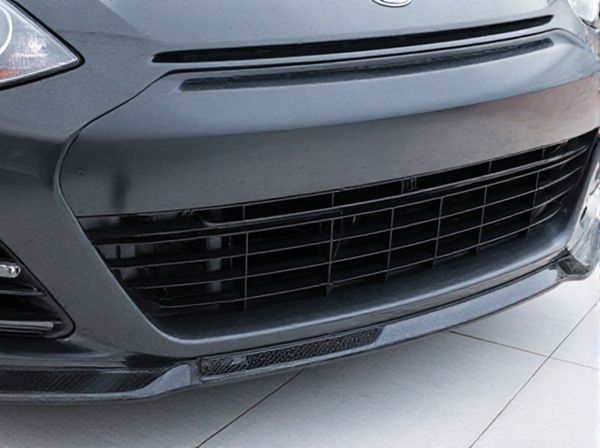
Photo illustration: Air Dam vs Chin Spoiler
An air dam is designed to reduce airflow underneath your vehicle, improving aerodynamic efficiency and decreasing lift at high speeds. A chin spoiler, often positioned lower on the front bumper, enhances downforce and sharpens the car's appearance while also aiding in airflow management. Both components contribute to better stability and performance but serve slightly different aerodynamic functions.
Table of Comparison
| Feature | Air Dam | Chin Spoiler |
|---|---|---|
| Location | Lower front bumper, extending downward | Front lip, attached beneath the bumper |
| Primary Function | Redirect airflow to reduce lift and drag | Enhance aerodynamic grip and styling |
| Material | Plastic, fiberglass, or carbon fiber | Plastic, fiberglass, or carbon fiber |
| Aerodynamic Effect | Improves high-speed stability by reducing air pressure under the car | Boosts downforce and improves cornering performance |
| Common Use | Performance and sports cars focusing on drag reduction | Sports and tuner cars emphasizing aggressive looks |
| Impact on Fuel Efficiency | Can improve by reducing drag | Minimal effect, mainly aesthetic |
| Installation | Usually bolt-on or integrated into bumper design | Bolt-on or adhesive options available |
Introduction to Air Dam and Chin Spoiler
Air dams and chin spoilers are aerodynamic components designed to improve vehicle performance by managing airflow. An air dam is installed on the lower front bumper to reduce air pressure underneath the car, minimizing lift and enhancing stability at high speeds. Chin spoilers, positioned just below the front bumper, streamline airflow and reduce drag, contributing to both improved fuel efficiency and handling.
Functionality: What Does an Air Dam Do?
An air dam primarily reduces aerodynamic drag by diverting airflow away from the vehicle's underbody, minimizing turbulence and improving fuel efficiency. It also enhances stability by increasing downforce on the front axle, which improves traction during high-speed driving or cornering. Unlike a chin spoiler that mainly serves aesthetic purposes, the air dam plays a critical role in optimizing airflow and vehicle performance.
Functionality: Role of a Chin Spoiler
A chin spoiler improves vehicle aerodynamics by redirecting airflow to reduce drag and increase downforce, enhancing stability at high speeds. Unlike an air dam, which primarily blocks air from flowing underneath the vehicle to decrease lift, the chin spoiler fine-tunes airflow around the front bumper to optimize performance. This targeted airflow control helps improve fuel efficiency and handling precision on both street and track.
Key Differences Between Air Dam and Chin Spoiler
Air dams are aerodynamic components mounted lower on the front bumper to reduce air flow under the vehicle, enhancing stability and reducing lift at high speeds. Chin spoilers, positioned beneath the front bumper's lip, primarily improve airflow management and add a sporty aesthetic, providing modest improvements in downforce. The key difference lies in their placement and aerodynamic function, with air dams focusing on minimizing underbody turbulence while chin spoilers target front-end airflow and styling.
Aerodynamic Impact on Vehicle Performance
Air dams and chin spoilers both serve to reduce aerodynamic drag and improve vehicle stability by directing airflow beneath the car. Air dams primarily block and redirect high-velocity air under the front bumper to reduce lift and enhance traction, optimizing downforce for better handling at high speeds. Chin spoilers complement this by smoothing airflow closer to the ground, further minimizing turbulence and drag, which collectively contributes to improved fuel efficiency and vehicle performance.
Material and Design Variations
Air dams typically use lightweight materials like ABS plastic or fiberglass to withstand lower road impacts and improve airflow beneath the vehicle, while chin spoilers often incorporate carbon fiber or polyurethane for enhanced durability and aerodynamic efficiency. Design variations in air dams emphasize minimizing drag and directing airflow to the undercarriage, featuring flat, broad surfaces with subtle contours. Chin spoilers are usually more sculpted and aggressive in shape to enhance front-end downforce and complement the vehicle's aesthetic appeal.
Pros and Cons of Air Dams
Air dams improve vehicle aerodynamics by reducing front-end lift and increasing stability at high speeds, which enhances fuel efficiency and handling performance. However, their low ground clearance makes them vulnerable to road debris, speed bumps, and curbs, potentially causing damage. Compared to chin spoilers, air dams offer more significant drag reduction but may require more careful driving on uneven surfaces to avoid wear and tear.
Pros and Cons of Chin Spoilers
Chin spoilers enhance vehicle aerodynamics by reducing front-end lift, improving stability at high speeds, and often contributing to a sportier appearance, making them ideal for performance cars. However, their low mounting position increases vulnerability to damage from road debris, curbs, and speed bumps, requiring careful driving and sometimes additional reinforcement. Unlike air dams that primarily direct airflow beneath the vehicle, chin spoilers offer a more aggressive aesthetic while balancing aerodynamic efficiency with practical durability concerns.
Installation and Maintenance Tips
Air dams install below the front bumper to reduce aerodynamic drag by directing airflow away from the undercarriage, typically requiring bolt-on mounts or brackets for secure attachment. Chin spoilers mount closer to the lower edge of the front bumper, often using double-sided automotive tape or small screws for a snug fit, enhancing front-end aesthetics while slightly improving downforce. Regular maintenance for both involves inspecting for damage, ensuring secure fasteners, and cleaning to prevent dirt buildup that can affect performance and durability.
Choosing the Right Option for Your Vehicle
An air dam reduces airflow under the vehicle to decrease lift and improve stability at high speeds, making it ideal for performance-oriented cars seeking enhanced aerodynamic efficiency. A chin spoiler, positioned lower on the front bumper, primarily directs airflow to improve engine cooling and reduce drag for daily-driving vehicles focused on fuel efficiency. Selecting the right option depends on your vehicle's purpose: choose an air dam for improved high-speed performance and handling, or a chin spoiler to optimize cooling and reduce front-end drag in everyday driving conditions.
 caratoz.com
caratoz.com